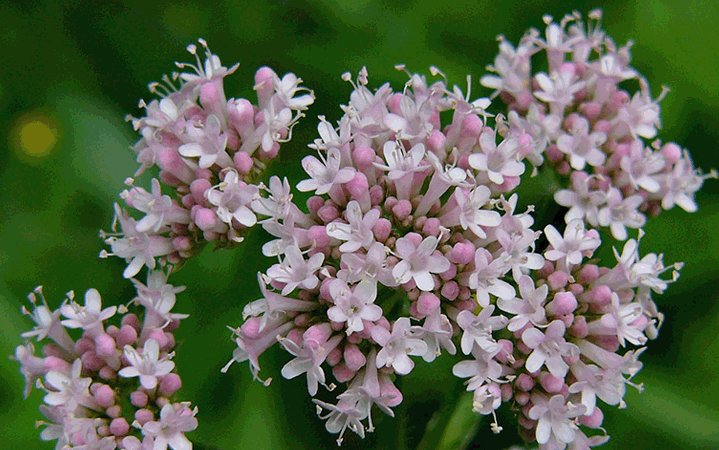Valerian (Valeriana officinalis, Caprifoliaceae) is a perennial flowering plant, with heads of sweetly scented pink or white flowers that bloom in the summer. Valerian flower extracts were used as a perfume in the 16th century.
History
Valerian has been used as a medicinal herb since at least the time of ancient Greece and Rome. Hippocrates described its properties, and Galen later prescribed it as a remedy for insomnia. In medieval Sweden, it was sometimes placed in the wedding clothes of the groom to ward off the “envy” of the elves.In the 16th century, the Anabaptist reformer Pilgram Marpeck prescribed valerian tea for a sick woman
John Gerard’s Herball states that his contemporaries found Valerian “excellent for those burdened and for such as be troubled with croup and other like convulsions, and also for those that are bruised with falls.” He says that the dried root was valued as a medicine by the poor in the north of England and the south of Scotland, so that “no broth or pottage or physicall meats be worth anything if Setewale [Valerian] be not there.”
The seventeenth century astrological botanist Nicholas Culpeper thought the plant was “under the influence of Mercury, and therefore hath a warming faculty.” He recommended both herb and root, and said that “the root boiled with liquorice, raisons and aniseed is good for those troubled with cough. Also, it is of special value against the plague, the decoction thereof being drunk and the root smelled. The green herb being bruised and applied to the head taketh away pain and pricking thereof.
Native to Europe and parts of Asia, valerian has been introduced into North America. The flowers are frequently visited by many fly species, especially hoverflies of the genus Eristalis.It is consumed as food by the larvae of some Lepidoptera (butterfly and moth) species including the grey pug.
Other names used for this plant include garden valerian (to distinguish it from other Valeriana species), garden heliotrope (although not related to Heliotropium), and all-heal (which is also used for plants in the genus Stachys). Red valerian, often grown in gardens, is also sometimes referred to as “valerian”, but is a different species (Centranthus ruber) from the same family and not very closely related.
Crude extract of valerian root is sold as a dietary supplement in the form of capsules. Valerian root may have sedative and anxiolytic effects.
The amino acid valine is named after this plant.
Medicinal use
Valerian is most often used as an alternative medicine for insomnia in place of hypnotic drugs. It is also sometimes used as an alternative for sedatives, such as benzodiazepines, in the treatment of certain anxiety disorders.
Whether or not valerian is an efficacious treatment for insomnia is still a very open question. Multiple recent systematic reviews of the medical research literature and meta-analyses have produced conflicting conclusions regarding its efficacy. One systematic review and meta-analysis published in 2006 concluded, “The available evidence suggests that valerian might improve sleep quality without producing side effects.” An article in the Medical Science Monitor states that, “…based on cellular and animal studies as well as human clinical trials the literature supports a role for these preparations [including valerian root] as useful alternatives in the management of the stress and anxiety of everyday life.” However, another systematic review, published in 2007 in the journal Sleep Medicine Reviews, concluded valerian was safe but not clinically efficacious for insomnia.
Η Βαλεριάνα (Valeriana Officinalis) είναι ένα από τα πιο γνωστά βοτανα στην υφήλιο αφού χρησιμοποιείται για πάνω από 2.000 χρόνια. Οι ιδιότητες της αναφέρθηκαν για πρώτη φορά από το Διοσκουρίδη το 50 π.Χ. Πρόκειται για φυτό που ευδοκιμεί σε ολόκληρη την Ευρώπη και σε μεγάλα τμήματα της Ασίας – λόγω της χρησιμότητας της έχει πρακτικά μεταφερθεί σε ολόκληρο το κόσμο. Χρήσιμο μέρος του φυτού είναι η ρίζα του.
Στη σύγχρονη βοτανοθεραπεία η Βαλεριάνα χρησιμοποιείται ως φυσικό ηρεμιστικό και χαλαρωτικό του νευρικού συστήματος. Σημαντική είναι η επίδραση της Βαλεριάνας σε περιπτώσεις αϋπνίας. Ανεξάρτητες κλινικές μελέτες έχουν αποδείξει τως η χρήση της Βαλεριάνας μειώνει το χρόνο που χρειάζεται για να μας πάρει ο ύπνος, μειώνει τη πιθανότητα να ξυπνήσουμε το βράδυ, επιμηκύνει το συνολικό χρόνο ύπνου και γενικότερα βελτιώνει τη συνολική ποιότητα του ύπνου, ανεξάρτητα αν κάποιος έχει πρόβλημα ή όχι. Για το λόγο αυτό η Βαλεριάνα είναι και γνωστή ως “God’s Valium”.
Η Βαλεριάνα θεωρείται πως είναι αποτελεσματική σε όλες σχεδόν τις περιπτώσεις νευρικών διαταραχών, όπως είναι το άγχος, η υπερένταση, οι πονοκέφαλοι, οι ημικρανίες και η ανησυχία. Η επίδραση της στο κεντρικό νευρικό σύστημα στηρίζεται σε πολλά συστατικά, με σημαντικότερο το GABA (gamma-aminobutyric acid).
Ένα από τα θετικά στοιχεία της Βαλεριάνας – σε σύγκριση με τα φαρμακευτικά προϊόντα – είναι πως δεν παρουσιάζει αρνητική αλληλεπίδραση με το αλκοόλ. Επίσης δεν παρουσιάζει παρενέργειες όταν καταναλώνεται σύμφωνα με τη προτεινόμενη ημερήσια δοσολογία.
H Βαλεριάνα περιέχει, μεταξύ των άλλων, πτητικά έλαια (0,5 – 2,0%), monoterpenes (0,4 – 1,4%), βαλεριανίνη, βαλερίνη, τανίνες κτλ.
Η αποξηραμένη ρίζα πρέπει να λαμβάνεται σε ποσότητα που να μην ξεπερνάει τα 10gr. ημερησίως. Οι θεραπευτές προτείνουν την παρασκευή αφεψήματος 2-3gr τρείς φορές την ημέρα για περιπτώσεις νευρικών διαταραχών ή μία κούπα (2-3gr) μία περίπου ώρα πριν τον ύπνο σε περιπτώσεις αϋπνίας.
Αν δεν έχετε το χρόνο για τη προετοιμασία ενός αφεψήματος, τότε σας προτείνουμε να δείτε το 100% φυσικό και ιδιαίτερα ισχυρό Βαμμα Βαλεριάνας, το οποίο είναι σε υγρή μορφή και έτοιμο για κατανάλωση.
Τα βότανα είναι και πρέπει να αντιμετωπίζονται ως φάρμακα. Δεν υποστηρίζουμε την αυτοθεραπεία και σας προτείνουμε να συμβουλεύεστε πάντοτε το γιατρό σας πριν από τη λήψη τους



